What is a product portfolio?
How do I create my portfolio as a product management aspirant?
Can it help me land a job opportunity?
Do I need to have technical skills to create a portfolio?
These are some of the most popular questions I frequently receive in my LinkedIn inbox.
If you have similar queries or want to create your product manager portfolio, you are in for a treat today.
This guide is a definitive resource for helping you understand a product management portfolio, how to create one, and finally, how to use one to get your next product interview and job.
Update: We have covered this post in one of our live sessions at HelloPM’s Product Management Bootcamp. Here is the video 👇🏽
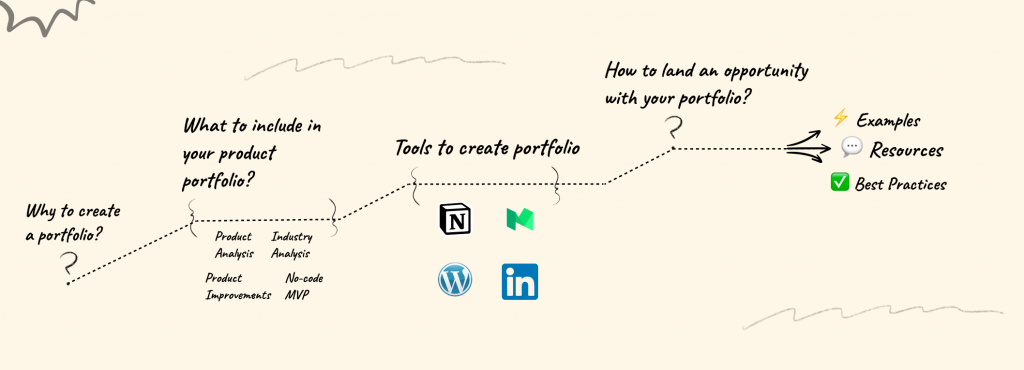
The guide is structured as follows, so please feel free to skip to the relevant section:
- What are the benefits of having a product portfolio?
- What should you include in a product portfolio:
- Popular tools to create your product portfolio.
- Examples of product portfolios
- How to get a job with your portfolio
- Issues with portfolio and workarounds
- Get your portfolio reviewed
What are the benefits of having a product portfolio as an (aspiring) product manager?
As with everything in product management, we will start our guide with a strong Why?
Why at all should you invest time and effort into creating a portfolio?
Let me be clear from the start that creating your portfolio is not going to be an easy task. You’ll have to commit time, and substantial efforts to create a remarkable portfolio.
Hence having a clear why will help you keep the motivation while creating a remarkable portfolio.
Here are three reasons why you should absolutely create a portfolio if you are an aspiring product manager.
- 10x your learning: Doing is the most effective form of learning. The act of creating a portfolio, helps you transform your learnings into a tangible outcome.
- Collect your learnings: A portfolio can also be used to collect your most important learnings through projects. Consider as a collection of your best product work, which you can refer to all along with your professional career.
- Get a job or internship: You can showcase your portfolio to your prospective employers as evidence of your product skills. This is particularly helpful for people who are looking to transition into product management and do not have any formal work experience to showcase their skills.
Before we move forward, here are a few examples of portfolios:
| Portfolio | Remarks |
| Anish’s Portfolio (HelloPM Cohort Member) | This portfolio has a lot of personality to it. Like an extended resume, has case studies, skills, and career background. |
| Surabhi’s Portfolio (HelloPM Cohort Member) | Easy to navigate and concise. Things that generally get lost in a resume like projects & personal story, are highlighted well. |
| Aparna’s Portfolio (HelloPM Cohort Member) | Detailed, long portfolio. Aparna has included her assignment submissions from the HelloPM cohort, which might help prospective employers understand her product skills. |
| Sugat’s Portfolio (Product Manager – Meta, HelloPM Mentor) | Sugat’s breakdown case study of CRED, helped him lead many interviews during his job hunt. An interesting example of articulating a product improvement. |
| Garett’s Portfolio (Product Designer at GoLoop & Canva) | This is like an ideal portfolio, Garett has included real examples from his work as a product leader/designer. Including the whole process, he and his team has gone through to create products. |
| Simon Pan (Product Designer at Google) | In another compelling portfolio, Simon has included real examples from his work as a product leader/designer at leading companies. Including the operational nuances of going through a product development life cycle. |
What should you include in a portfolio for product managers?
Product portfolios come in different shapes and sizes, however, the aim of all of them is to showcase your product skills.
As per the ideal definition of a portfolio, it should contain all the product work that you have done in the past. For example, in his portfolio, Garett has mentioned about Youtube Mockup Tool, Create with Google and other projects he has worked on as a part of his job.
However, including your past work at a PM, job might not be enough for building a strong portfolio:
- You might be an aspiring product manager, so you don’t have any real work to show yet.
- Although you have been a product manager, you didn’t work on something that you could proudly showcase (internal products, execution work, the product didn’t launch, etc.)
- Your employer might not allow you to share the work publicly.
So while it is ideal to include your past work, it’s practical to consider your portfolio as a repository of your learnings around product management.
Here are what you can include in your portfolio: (In decreasing order of effectiveness, and increasing order of ease of creation)
- Past Product Work
- Side Projects
- Product Improvement & Creation Case Studies
- Product TearDown Case Studies
- Commentary and Content
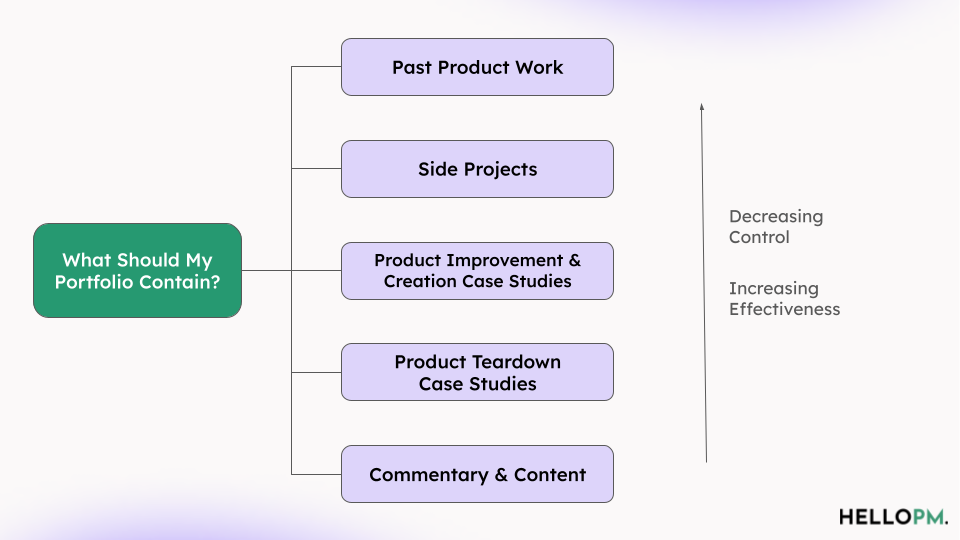
Most of the time people just add their knowledge about product management concepts through a blog post and call it a portfolio. While its better than nothing, it might not be as effective when compared to portfolios which include things mentioned at the top of the list.
✅ Past Product Work
This is the most credible and effortful work that you can add to your product portfolio.
People who have worked in product or adjacent roles can showcase their process of building a product, improving a feature, or any part of the product management cycle that they have participated in.
Focus on articulating your process of finding and validating the problem, and showcase the artifacts that you created while building the product.
Here are major pointers you can include while showcasing your past work:
- What user problem were you solving? How did you arrive at it? How was it validated?
- How did this align with the business goals?
- How did you come up with solutions, and their prioritization? Briefly talk about other solutions that were close but weren’t picked.
- How did you release it to the audience?
- How have you collaborated with different stakeholders?
- How did you measure success? What happened after the release?
Answering these questions on your past work will give your portfolio work a decent structure.
Also, even if you didn’t work as a product manager directly but worked in an adjacent role like sales, marketing, design, development, etc, you can still ask these questions to your product managers to learn in detail. This will help you understand the product process well.
While mentioning this in your portfolio, don’t forget to mention your exact contribution.
✅ Analysis and comparison of different products:
You can pick a product of your choice and do an exhaustive product analysis. You can find products from platforms such as the Play Store, App Store, Product Hunt, or even the product of the company you want to apply for a job at.
Here is what you can include in your analysis:
1. What problem(s) does the product solves?
2. Who is facing this problem (user persona)?
3. What the user journey looks like?
4. Who are the competitors and how are they solving this problem?
5. What is unique about this product?
6. How does this makes money?
To get brownie points, you can talk to actual users to answer the above questions.
Here are a few similar analyses for your inspiration:
1. Mansi’s & Kirti’s analysis and suggestions of Quora
2. Chetan‘s analysis and suggestions for ProductHunt.
(Chetan, Mansi, and Kirti are participants of our product management bootcamp) .
Once done, you can then include this analysis in your portfolio webpage.
💬 Comparing products in popular categories
Here you start with a category in mind and analyze the different products in that category. For example, you can choose the category to be food delivery apps, and can now compare Swiggy and Zomato side by side.
This will help you understand market dynamics, user needs, and differentiating factors among sumilar products.
In this analysis you can explore things like:
1. Dynamics of this market. How big is the market, and how is it growing?
2. User insights: Who are the popular users in this category, and what problems got them to use these products?
3. What are the different products in this category? Can you further categorize them?
4. Create a feature comparison and pricing comparison chart.
5. What differentiates one product from the other?
6. If users have to choose one among them, which one would they choose and why?
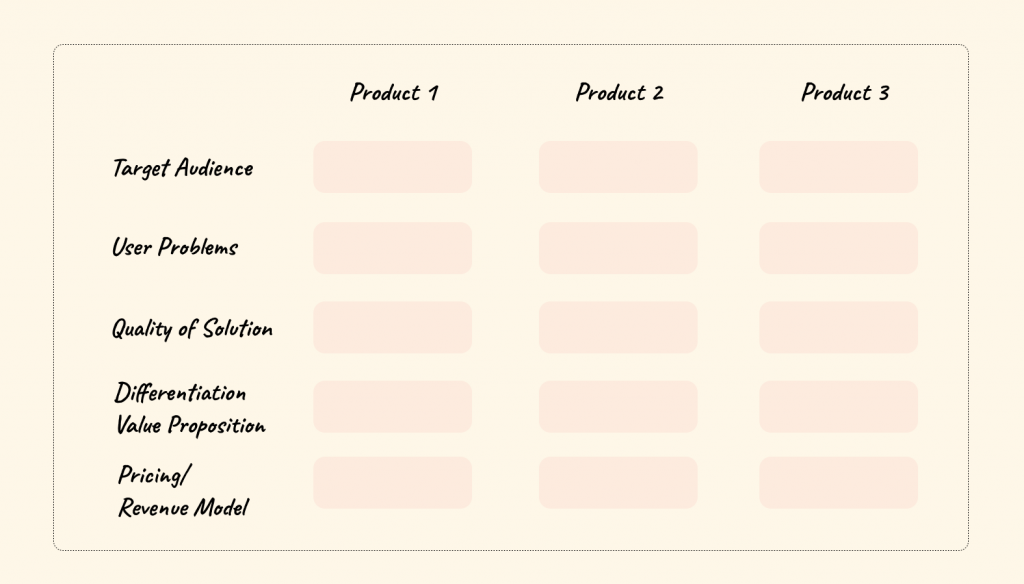
You should read reviews about the products from sites such as Quora, Reddit, G2Crowd, TrustPilot, etc. A list of websites that can help you with your industry research at given in the footnotes of this article.
🛠 Improving a product
Here you can go a step ahead, and start suggesting the improvements in the popular products. You can choose a product of your choice and follow the product thinking framework to suggest some improvements.
As the concluding step, you will also use some design tools like Figma, to actually showcase your improvements as wireframes or high fidelity designs.
Here is the framework product managers generally follow to improve any product:
1. Find the users who might be using the product (user persona).
2. Find their problems (these problems could be inside the product or might be related to the core jobs to be done for the users).
3. Prioritize the problems based on the estimated impact of solving them.
4. Come up with multiple solutions for the top problems.
5. Prioritize the solutions by using the simple Impact v/s Effort comparison.
6. For the top prioritized solution, create the user flow and design (wireframes or actual)
7. Decide the metrics which you would measure to find out the success of this improvement.
You can articulate these steps in your analysis and add them to your portfolio.
These kinds of analyses could become a very strong talking point in your product interviews.
🧙🏻♂️ Design a solution for a problem
In this kind of portfolio item, you start with a problem and come up with your solutions (in the form of products) to solve them.
For example, many people face the problem of forgetting what they read, to solve this problem we could have multiple solutions. One solution could be to do timely revision through flashcards, sending yourself automated emails in the future with some content to revise, etc.
Now you can wear your product hat, think of a few problems you and people you know face frequently, and how can you create a solution for that.
You can either just create a wireframe or design for the solution, or you can go a step further to use a no-code tool to actually bring it to life.
Few points that might help you in this exercise:
1. You can use the design thinking framework to come up with solutions.
2. You should talk to other people who might be facing similar problems to empathize and understand better.
3. You should estimate the demand for this kind of product (guesstimate).
4. You should test this finished solution with multiple people to understand the adoption and plan the next possible iterations.
Here are some tools and resources to help you create designs:
| Figma | A powerful tool to create any kind of design work from wireframes to full-fledged dev-ready designs. |
| Balsamiq | The go-to tool for creating wireframes. |
| Whimsical | Create flow diagrams, wireframes, and lot more with this easy-to use tool. |
| Adobe XD | A powerful tool from adobe to create any kind of design work from wireframes to full-fledged dev-ready designs. |
| Canva | A beginner-friendly tool to create basic designs and presentations. |
👷🏾 Build something with a no-code tool
This is an extension of the previous exercise. With so many powerful yet easy-to-use no-code tools, there is nothing stopping you from bringing your simple product ideas to life.
If you are able to add something like this to your portfolio, it would definitely be the highlight, and most probably make your profile stand out.
Even if you know how to code, I would strongly recommend you to try some of these out, as they drastically reduce the time to ship and iterate.
Here are a few tools and related tutorials to help you create your own products with knowing how to code.
| Use Case | No Code Tool | Quick Start |
| Create a website | WebFlow | Tutorial |
| Wix | Tutorial | |
| Cardd | Tutorial | |
| Create Web Apps with Data | Xano | Tutorial |
| Notion | Tutorial | |
| Airtable | Tutorial | |
| Create Mobile App | Glide | Tutorial |
| Bravo | Tutorial | |
| Bubble | Tutorial | |
| Automation & Integrations | Integromat | Tutorial |
| Zapier | Tutorial | |
| IFTTT | Tutorial |
Inspire yourself: Here are a few products built with no-code tools.
🚀 Launch a product and document your journey (Side Projects)
This is taking your product journey to a whole new level.
By actually launching and taking your product to the market you will understand integral concepts of product management like customer development, experimentation, creating a go-to-market strategy, etc.
The users with whom you have done your initial research could be the first set of users for your finished product. If you keep documenting your journey in public, people would find your product and the bandwagon will continue.
You can launch your product on Producthunt, Reddit, BetaList, or even on your personal social network profile on LinkedIn, Twitter (or even your WhatsApp status update)
Few resources that can help you in this journey:
1. Read inspiring stories from solopreneurs creating their products.
2. Follow the buildinpublic hashtag on twitter.
3. Jump on these subreddits
Make sure you are connecting with the right people in your journey to grow your network and learnings.
💡 This could also be a sweet little side project which might be added to this list someday.
A great portfolio generally contains a combination of all the items explained above.
Popular tools to create your product portfolio
There are lots of tools through which you can create a well presentable portfolio, so much so that sometimes choosing one could become overwhelming. I have seen folks using their social profiles as portfolios and that is perfectly fine. While every tool and platform has its pros and cons, I strongly would suggest you go ahead choose anyone right now and start creating. Getting started is the most important part of your portfolio creation journey.
Notion
The top tool I would recommend is notion. It’s super easy to get up and running without any setup.
Just create an index page where you can keep adding the pages and links later on. The SEO discovery might be an issue here but that doesn’t stops you from sharing your portfolio and work with anyone through the direct link.
WordPress
You can create a portfolio in WordPress. It’s beginner-friendly and you can use its block editor to add any information, host files, and even get good discovery through search engines.
While the free version (wordpress.com) has limitations, you can use the self-hosted version (wordpress.org) with any of the popular hosting companies and host your portfolio on your own domain. This might cost you around $10 every month or so, you will get so many designs to choose from and will look more professional.
Medium
Medium.com is another platform to get started with your product journey documentation. I am sure many of the case studies, and articles we have read so far have been hosted on medium only.
The platform is SEO friendly, free, easy to get started, and might get your additional reach through recommendations and newsletter. Recently they have started blocking content to get people to signup/pay before they could read content, so just keep that in mind.
Portfolio platforms
Platforms such as Behance, Dribble, UXFolio, etc. can also be used to host your product portfolio. They were originally made for UX/UI designers but could be used by product managers as well to host analysis, wireframes, etc.
Secondary resources to help you build a portfolio:
Here are a few additional resources to help you create a presentable portfolio
| Use Case | Tool |
| Presentations | Google Slides Templates |
| Canva Slide Templates | |
| Figma Slide Templates | |
| Icons and Design Elements | UnDraw |
| Icons8 | |
| Figma Community | |
| Images and Videos | Pexels |
| FreePik | |
| UnSplash | |
| Mockups and Screenshots | Dimmy.club |
| Screen.Traction.One | |
| Video & Screen Recording | Loom |
| Jitter Video |
Examples of product portfolios:
This is still a work-in-progress section, I will keep updating as I come across more portfolio examples. Feel free to send your recommendations. (Some of the below are one-off analyses)
- Mark Progano’s Product Portfolio
- Elezea’s Product Portfolio
- Sugat improving CRED (Sugat is an instructor at our product management bootcamp) .
- Chandan’s Portfolio (Participant in 2nd cohort)
- Prasad’s Portfolio
- Chetan’s features section on LinkedIn. (Participant in 5th cohort).
How to get a job through a product portfolio
Your product portfolio can give assurance to your prospective employers that you have an understanding of how products are synthesized and shows your passion for product management.
Here are few ways to get your portfolio across the employers and the public:
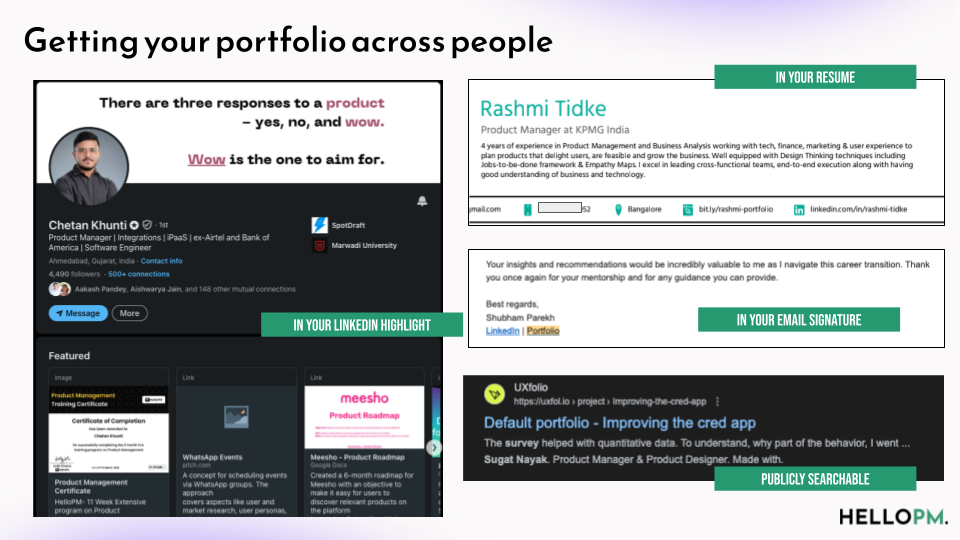
You can mention your portfolio in the resume itself. You can also send it to some decision-makers or product managers in the companies you are looking to work with for feedback and input.
In your cover letters, or initial emails to HR/Recruiter/Interviewer you can attach your product portfolio and mention how some of it could be relevant to this organization as well.
You should also actively share your work on social media platforms too. You don’t know when serendipity strikes and you get your future opportunity from one of your portfolio viewers.

Issues with the product portfolio and work-arounds
There might be a critical issue while you are searching for a product job with your portfolio: Most interviewers, hiring managers, and decisions makers might not have time to go through your portfolio.
Understand this, these people receive 100s of applications for job openings, and even if 20% of them attach some kind of portfolio, it becomes very difficult for them to go through everything in detail when they don’t have any additional incentive.
As a product manager, if you understand this problem correctly, you definitely can find workarounds.
Two of the many possible workarounds could be
- Look out for companies that are in the same domain, or are solving similar problems that you’ve covered in your portfolio.
Make sure you mention this in your initial email or resume so that they don’t miss out.
Now you can apply for all companies in that domain even if they don’t have an active job opening. Good companies are always looking for great candidates who are passionate about the industry and problem statement. - You can also create items in your portfolio that are either similar or closely related to the product of the company where you are looking to apply. Many candidates from HelloPM have created case studies for companies and sent them pro-actively. Most of them were able to get an interview and grab a product management role at the company.
In both of the cases above, the likelihood of your prospective employer checking your work will be much more because it’s something that they are actively working on.
In the end:
Please do not create the portfolio, just for the sake of getting the job, but enjoy the process and see your product thinking and problem-solving capabilities transform.
While a great product portfolio can help you get the job of your dreams, but that shouldn’t be your only aim. You transform yourself when you take on such challenges. You learn by doing.
Attaching something from one of the best teachers of all time: Richard Feynman

Get your portfolio reviewed
Enough of reading, now go ahead and take action. Pick up the product you love and write a blog post about your experience of using it and how you can improve it?
Once done do send me a link here as DM, I would be glad to send you my feedback (limited time).
Footnotes & Additional resources
List of websites for product and market research:
- Long form articles about various India and SEA companies and markets: AJuniorVC
- Solid coverage around finance and economics from India: Finshots
- Resources from Accel India around products and startups: Accel India Blog
- Similar resources from Blume: Blume Blog
- Announcement from RBI (for finance folks): RBI
- Annual reports from public companies in India: LearnStockMarket
- Annual reports from public companies in the US: SEC Filings
List of websites for examples around product case studies:
- Visual break-downs and improvements of various popular apps: Growth.design
- Product case studies from MindTheProduct: MindTheProduct
- Creating case study solutions: AgileInsider
Here are a few more resources for market research:
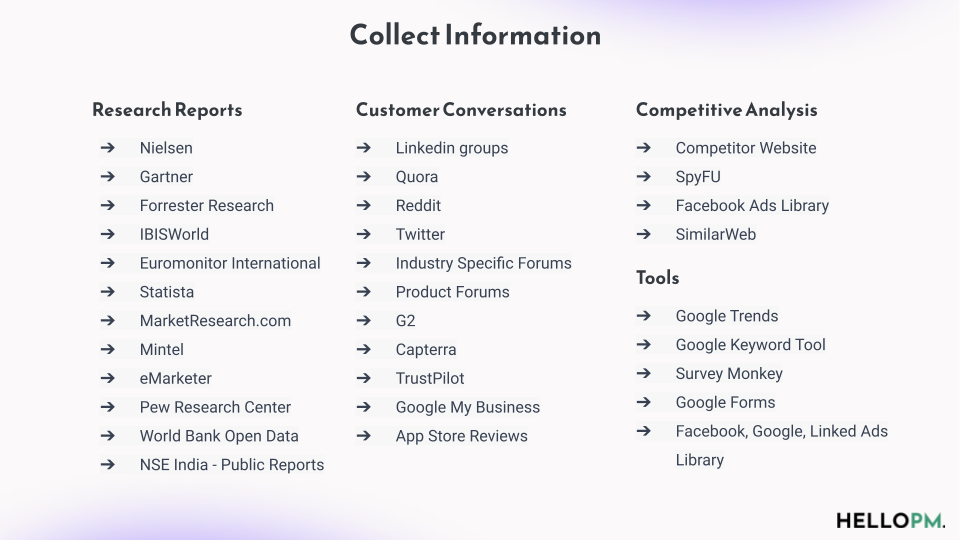
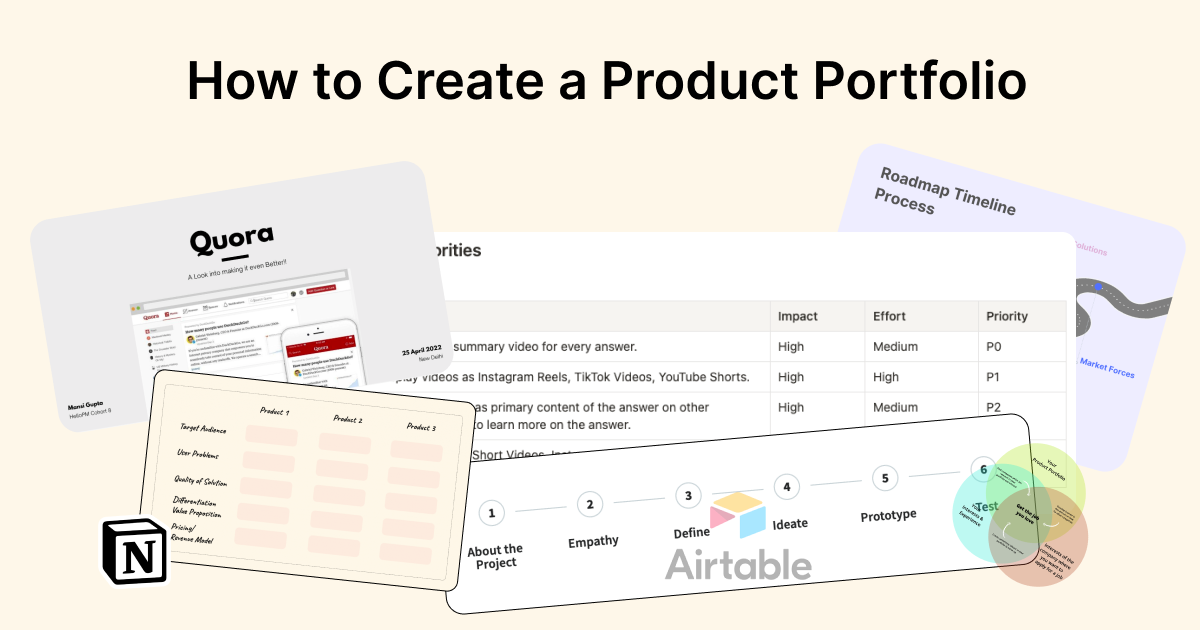
 WATCH HELLOPM COHORT IN ACTION
WATCH HELLOPM COHORT IN ACTION



0 thoughts on “How to make a Product Manager Portfolio – The complete guide with Examples, Tools, Templates, and Free Resources for PM Portfolio”
Comments are closed.